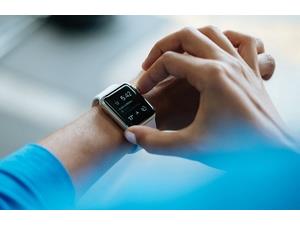



Date:31/05/19
 Global shipments of wearable devices in the first quarter of 2019 were up more than 55% from the same period last year, reaching 49.6 million units, according to IDC's Worldwide Quarterly Wearable Device Tracker, with wrist-worn devices claiming the lion's share of the market.
Global shipments of wearable devices in the first quarter of 2019 were up more than 55% from the same period last year, reaching 49.6 million units, according to IDC's Worldwide Quarterly Wearable Device Tracker, with wrist-worn devices claiming the lion's share of the market.
The report found that wrist-worn wearables accounted for more than 63% of the market, while ear-worn devices, such as Apple's AirPods, made up a share of 34.6% but were the fastest growing segment, enjoying an increase of 135% year-on-year.
"The elimination of headphone jacks and the increased usage of smart assistants both inside and outside the home have been driving factors in the growth of ear-worn wearables," remarked Jitesh Ubrani, research manager for IDC Mobile Device Trackers. "Looking ahead, this will become an increasingly important category as major platform and device makers use ear-worn devices as an on-ramp to entice consumers into an ecosystem of wearable devices that complement the smartphone but also offer the ability to leave the phone behind when necessary."
Apple maintained its market leadership position during 1Q19, with its three popular product offerings, the Apple Watch, AirPods and select Beats headphones, seeing significant sales. The company has been attempting to diversify its product offerings of late in the wake of waning smartphone sales and, in January this year, it was revealed that Apple wearables have beaten iPod sales even when the music player was "at its peak".
Xiaomi was the next biggest contributor to the market, with IDC attributing the firm's success to the popularity of its Mi Band, which accounted for around five million shipments in 1Q19. In third place was Huawei, who experienced market-beating growth of more than 282% during the period. Samsung and Fitbit took fourth and fifth place, respectively.
In October 2018, CCS Insight projected that the wearables market would double between 2018–22, with 233 million units being shipped in 2022 causing the market to skyrocket to a $27bn valuation. CCS Insight put the growth in the market largely down to a surging interest in digital health, with in-built health features being a significant part of what many of the market's leading products offer.
Almost 50 million wearables shipped in first quarter of 2019
 Global shipments of wearable devices in the first quarter of 2019 were up more than 55% from the same period last year, reaching 49.6 million units, according to IDC's Worldwide Quarterly Wearable Device Tracker, with wrist-worn devices claiming the lion's share of the market.
Global shipments of wearable devices in the first quarter of 2019 were up more than 55% from the same period last year, reaching 49.6 million units, according to IDC's Worldwide Quarterly Wearable Device Tracker, with wrist-worn devices claiming the lion's share of the market.The report found that wrist-worn wearables accounted for more than 63% of the market, while ear-worn devices, such as Apple's AirPods, made up a share of 34.6% but were the fastest growing segment, enjoying an increase of 135% year-on-year.
"The elimination of headphone jacks and the increased usage of smart assistants both inside and outside the home have been driving factors in the growth of ear-worn wearables," remarked Jitesh Ubrani, research manager for IDC Mobile Device Trackers. "Looking ahead, this will become an increasingly important category as major platform and device makers use ear-worn devices as an on-ramp to entice consumers into an ecosystem of wearable devices that complement the smartphone but also offer the ability to leave the phone behind when necessary."
Apple maintained its market leadership position during 1Q19, with its three popular product offerings, the Apple Watch, AirPods and select Beats headphones, seeing significant sales. The company has been attempting to diversify its product offerings of late in the wake of waning smartphone sales and, in January this year, it was revealed that Apple wearables have beaten iPod sales even when the music player was "at its peak".
Xiaomi was the next biggest contributor to the market, with IDC attributing the firm's success to the popularity of its Mi Band, which accounted for around five million shipments in 1Q19. In third place was Huawei, who experienced market-beating growth of more than 282% during the period. Samsung and Fitbit took fourth and fifth place, respectively.
In October 2018, CCS Insight projected that the wearables market would double between 2018–22, with 233 million units being shipped in 2022 causing the market to skyrocket to a $27bn valuation. CCS Insight put the growth in the market largely down to a surging interest in digital health, with in-built health features being a significant part of what many of the market's leading products offer.
Views: 568
©ictnews.az. All rights reserved.Similar news
- Azerbaijani project to monitor disease via mobile phones
- Innovative educational system to be improved under presidential decree
- NTRC prolongs license of two TV and radio organizations for 6 years
- Azerbaijan establishes e-registry for medicines
- Azerbaijani museum introduces e-guide
- Nar Mobile opens “Nar Dunyasi” sales and service center in Siyazan city
- International conference on custom electronic services held in Baku
- OIC secretary general to attend COMSTECH meeting in Baku
- Azerbaijan develops earthquake warning system
- New law to regulate transition to digital broadcasting in Azerbaijan
- Azerbaijani State Social Protection Fund introduces electronic digital signature
- Intellectual traffic management system in Baku to be commissioned in December
- Tax Ministry of Azerbaijan started receiving video-addresses
- World Bank recommends Azerbaijan to speed up e-service introduction in real estate
- Azerbaijan to shift to electronic registration of real estate





















